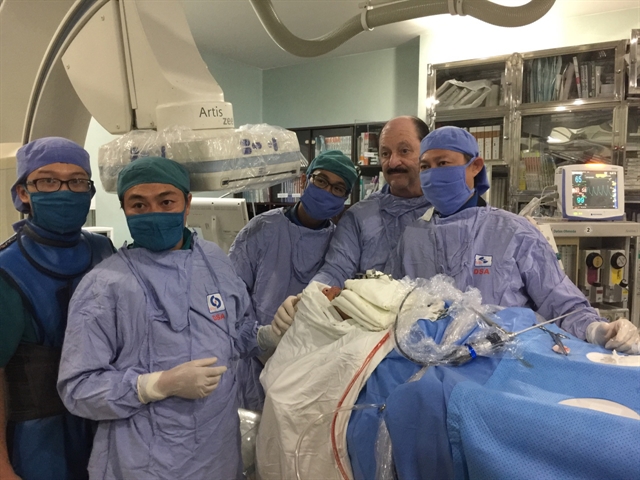 Society
Society

Patients with vascular malformations can be effectively treated by using absolute ethanol, according to experts.

|
| Dr Wayne F. Yakes (2nd R), director of Yakes’s vascular malformations centre in the US, trains doctors at HCM City’s Gia Định People’s Hospital in using absolute ethanol to treat vascular malformations. Photo courtesy of the hospital. |
HCM CITY — Patients with vascular malformations can be effectively treated by using absolute ethanol, according to experts.
Dr Nguyễn Đình Luân, head of interventional radiology (IR) and deputy head of the department of radiology at the Gia Định People’s Hospital, said these patients used to go around looking for a cure in the past.
Surgery plays an important role in small, located and superficial vascular malformations, but most of them are diffuse, ill surrounded and relate to bone, muscle or vital as well as functional organs, in which case surgery could seriously harm the patient’s body, he said.
Interventional radiology nowadays plays an important role in the management of vascular malformations. Various materials are used to embolise vascular malformations, including glue N-butyl cyanoacrylate (NBCA), onyx and sclerosant agents in the case of neurovascular malformations.
Absolute ethanol is a destructible sclerotherapy or a minimally invasive procedure used to treat abnormal or enlarged blood vessels, usually varicose veins.
An 18-21 gauge needle is inserted into the centre of the malformation and absolute alcohol is injected directly into it.
Because of toxicity of pure alcohol to the human body, a limited amount of alcohol should be used at a time. Thus, managing vascular malformation by using alcohol is often divided into multiple sessions.
With help from Dr Wayne F. Yakes, director of Yakes’s vascular malformations centre in Denver, the US, doctors at the Gia Định People’s Hospital have been performing this technique since 2016.
Yakes is considered the most experienced in the world in this technique after practising it for more than 30 years, and trains doctors all over the world.
On June 20 and 21, Yakes and the IR Unit at the hospital’s radiology department held a workshop on treating vascular malformations, where 28 patients were chosen for management of the condition.
They included people with venous, capillary, and arteriovenous malformations in every part of the body. They ranged in ages from six to 42 and from the first session of alcohol treatment to advanced stages.
One of them was a young woman with venous malformations in the left neck that had diffused to her larynx, causing difficulty in breathing and cosmetic problems.
She was treated when young through surgery, but the condition persisted and slowly worsened again.
Vascular surgeons refused to treat her surgically again, and so interventional radiological approach was an appropriate choice.
She had had alcohol injected two times before, and this was the third session.
According to Yakes and Luân, some 1 per cent of the global population suffers from vascular malformations, including in the central nervous system or its periphery. Management is chosen in case of clinical symptoms or cosmetic problems.
The rate of cure using various treatments is low but Yakes said alcoholic treatment has a higher chance than others.
In Luân’s unit, many cases have been successfully controlled or cured using this technique.
But Yakes said vascular malformations should be treated using multiple methods.
Vascular malformations and hemangioma should be distinguished from each other.
So patients need to consult experts and use imaging such as ultrasound, computed tomography or even magnetic resonance imaging for a precise diagnosis.
Once a patient is finally diagnosed, a tailored treatment is chosen by experts. — VNS